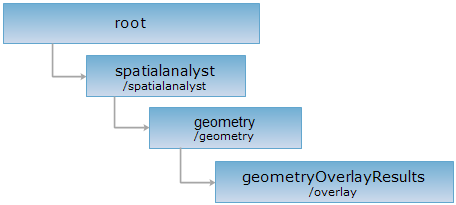URI
<geometry_uri>/overlay[.<format>]
Supported methods
Parent resource
Child resources
Introduction
Result set resources for geometry object overlay analysis.
Supported methods
- GET: Get a form for the POST request.
- POST: create a geometry object overlay analysis result resource.
- HEAD: Check whether the geometryOverlayResults resource exists or whether the client has the permission to access the geometryOverlayResults resource.
Supported output formats: rjson, json, html, xml.
GIS Services Resource Hierarchy

http://supermapiserver:8090/iserver/services/spatialanalyst-sample/restjsr/spatialanalyst/geometry/overlay.rjson
GET Request
Gets a form for the POST request.
POST request
Performing a POST request on the resource with related parameters creates the resource of a spatial analysis result, i.e., performs an overlay analysis.
Request parameters
Parameters in the URI are as follows:
| Field | Type | Definition |
| asynchronousReturn | boolean | Whether to adopt asynchronous operation. If true, the URI of the new resource will be immediately returned after the clients submit a request (i.e., the setting of returnContent is not effective); if false, the representation or the URI of the new resource will be returned according to the setting of returnContent once the analysis is finished on the server. The default value is false. |
| returnContent | boolean | Returns the description or the URI of the new resource. If true, returns the description for the analysis result. If false, returns the URI. The default is false. |
Parameters in the request body are as follows:
| Name | Type | Description |
|
sourceGeometry |
Geometry |
|
| operateGeometry | Geometry | The operating geometry object of the region type. |
| operation | String | The overlay operation. The operations include clip, erase, identity, intersect, union, update, and XOR. |
Response structure
Normal response code(s): 201. The response parameters are as follows:
| Name | Type | Description |
|
succeed |
boolean | Whether query is successful. |
| newResourceID | String | The ID for the query result resource. |
| postResultType | PostResultType |
The type of the result from a POST request. Lists and describes the impact of a POST request on the target resource, i.e., the analysis result. |
| newResourceLocation | String | The URI of the newly created resource. |
Example of response
Perform the POST request on the overlay resource with http://supermapiserver:8090/iserver/services/spatialanalyst-sample/restjsr/spatialanalyst/geometry/overlay.rjson and the response in rjson format is as follows:
{
"sourceGeometry": {
"type": "REGION",
"points": [{
"x": 23,
"y": 23
},
{
"x": 33,
"y": 35
},
{
"x": 43,
"y": 22
}]
},
"operateGeometry": {
"type": "REGION",
"points": [{
"x": 23,
"y": 23
},
{
"x": 34,
"y": 47
},
{
"x": 50,
"y": 12
}]
},
"operation": "CLIP"
}
The response in json format is as follows:
{
"succeed": true,
"newResourceID": "1",
"postResultType": "CreateChild",
"newResourceLocation": "http://supermapiserver:8090/iserver/services/spatialanalyst-sample/restjsr/spatialanalyst/geometry/overlay/1"
}
Perform the GET request on http://supermapiserver:8090/iserver/services/spatialanalyst-sample/restjsr/spatialanalyst/geometry/overlay/1.rjson can get the overlay analysis result. Please see geometryOverlayResult.
HEAD request
Asks for the response identical to the one that would correspond to a GET request, but without the response body. This is useful for retrieving meta-information written in response headers, without having to transport the entire content. The meta-information includes the media-type, content-encoding, transfer-encoding, content-length, etc.
HEAD request can be used to check if the geometryOverlayResults resource exists, or if the resource can be accessed by clients. It can also determine if the geometryOverlayResults resource supports an output format <format> if performing on a URI with .<format> included.